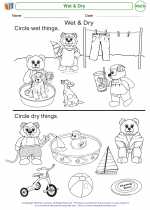Wet & Dry
In Kindergarten math, children learn about the concept of wet and dry. This topic introduces them to the idea of the different states of materials, particularly focusing on the properties of liquids and solids.
Wet:
Children learn that when something is wet, it means that it has water or another liquid on it. They may explore different objects or materials that become wet when they come into contact with water, such as sponges, towels, or their own hands after washing them.
Dry:
On the other hand, when something is dry, it means that it does not have any water or liquid on it. Children are taught to identify and differentiate between items that are dry and those that are wet. They may also learn about the process of drying, such as when wet clothes are hung outside to dry in the sun or when a spill is wiped up with a towel.
Activities:
To help children understand the concept of wet and dry, teachers and parents can engage them in various hands-on activities. For example, they can conduct simple experiments where children observe how different materials react to water, or they can sort objects into "wet" and "dry" categories. Additionally, children can have fun with water play activities, such as pouring, splashing, and using sponges to explore the properties of wetness.
By learning about wet and dry, children develop an early understanding of the physical properties of materials and the concept of states of matter, which lays the foundation for more advanced scientific concepts in the future.
.

